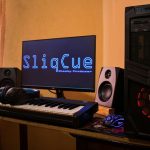Looking to maximize your home office setup?
Did you know that over 70% of professionals use a monitor as part of their home office? Getting sound from your monitor can enhance your work experience.
Here are 5 ways to achieve this:
- Use an HDMI or DisplayPort connection for built-in audio
- Connect via USB-C or Thunderbolt for digital audio
- Pair a Bluetooth speaker or headphones for wireless sound
- Consider external monitor speakers for an all-in-one solution
- Utilize an audio jack or adapter for traditional connectivity.
Let's dive into these options and elevate your home office audio game.
Key Takeaways
- HDMI or DisplayPort connection allows for built-in audio and the option to connect speakers or headphones to the monitor.
- USB-C or Thunderbolt cables can provide enhanced sound quality and the choice between a soundbar or speakers, with considerations for space availability and audio preferences.
- Bluetooth speakers or headphones offer wireless sound with comparable quality to wired connections, taking into account factors like sound quality, battery life, range, comfort, and advanced audio codecs.
- External monitor speakers can enhance audio output, providing richer and more detailed sound, with proper placement for optimal transmission. Additionally, audio jacks or adapters can be used to connect the monitor to external speakers, with options for wireless audio adapters for cable-free flexibility.
HDMI or DisplayPort Connection
If you want to get sound from your home office monitor, you can do so by connecting your speakers to your monitor using either an HDMI or DisplayPort connection. When setting up your audio, it's crucial to ensure that your monitor is compatible with the chosen connection method.
Most modern monitors come with built-in speakers, but for a better audio experience, connecting external speakers or headphones can greatly enhance sound quality. To do this, you need to check if your monitor has an HDMI or DisplayPort audio output.
Once you've established compatibility, you can proceed to adjust the audio settings on your computer to route the sound through the monitor. This may involve selecting the monitor as the default audio output device in your computer's settings.
Additionally, you may need to adjust the audio settings on the monitor itself to ensure that the sound is properly routed through the connected speakers.
USB-C or Thunderbolt Cable
To ensure seamless audio connectivity, consider utilizing a USB-C or Thunderbolt cable to enhance the sound quality from your home office monitor. When deciding between a soundbar and speakers for your home office setup, it's essential to consider the space available, your audio preferences, and the level of flexibility you require. Additionally, you'll need to choose between a wireless or wired connection to transmit audio from your monitor to the sound output device. Below is a comparison table to help you weigh the options:
| Aspect | Soundbar | Speakers |
|---|---|---|
| Audio Quality | High-quality virtual surround sound | Clear stereo sound |
| Space Requirement | Compact and space-saving | Require more space |
| Flexibility | Limited placement options | Versatile placement options |
| Wireless Connection | Often have built-in Bluetooth for wireless connection | Require additional adapters for wireless connection |
| Wired Connection | Typically have multiple input options including USB-C or HDMI | Require cables for connection to the monitor |
When making your decision, consider your specific needs and preferences to ensure the best audio experience in your home office.
Bluetooth Speaker or Headphones
Consider using Bluetooth speakers or headphones for convenient, wireless sound from your home office monitor.
When it comes to wireless versus wired sound, Bluetooth speakers or headphones offer the advantage of eliminating cable clutter and providing the freedom to move around without being tethered to your monitor. While wired connections may offer slightly better sound quality due to the lack of signal compression, Bluetooth technology has advanced significantly, and many high-quality Bluetooth speakers and headphones now provide sound quality that rivals wired connections.
When choosing Bluetooth speakers or headphones, consider factors such as sound quality, battery life, and range. Look for Bluetooth speakers with high-quality drivers and advanced sound processing for superior audio performance. For headphones, prioritize comfort, sound isolation, and audio fidelity. Some Bluetooth headphones also support advanced audio codecs like aptX and LDAC, which can significantly improve sound quality compared to standard Bluetooth audio. Additionally, newer Bluetooth versions such as Bluetooth 5.0 offer improved connectivity and range.
Ultimately, Bluetooth speakers or headphones provide the convenience of wireless sound without sacrificing significant sound quality, making them a practical choice for your home office monitor setup.
External Monitor Speakers
For optimal sound quality and a more immersive audio experience, you can also consider using external monitor speakers with your home office setup, avoiding the limitations of built-in monitor speakers and exploring other audio options. External monitor speakers can significantly enhance the audio output of your computer, providing richer and more detailed sound. When choosing external monitor speakers, it's essential to consider factors such as sound quality and speaker placement to maximize your listening experience.
Consider the following factors when selecting external monitor speakers:
| Factors | Description | Tips |
|---|---|---|
| Sound Quality | Look for speakers with high fidelity and | Research speaker brands known for their |
| excellent frequency response for clear | audio quality and read customer reviews. | |
| and accurate sound reproduction. | Place the speakers at ear level for optimal | |
| sound transmission. | ||
| Speaker Placement | Proper placement can significantly | Position the speakers symmetrically and at |
| impact sound quality. | an equal distance from your listening | |
| position. |
Audio Jack or Adapter
You frequently connect your monitor to external speakers using an audio jack or adapter for improved sound quality in your home office setup. When it comes to getting sound from your home office monitor, using an audio jack or adapter can greatly enhance your audio experience.
Here are some key considerations for utilizing an audio jack or adapter:
- Wireless Audio: Explore the option of wireless audio adapters to eliminate the hassle of dealing with cables and cords, providing you with more flexibility in arranging your workspace.
- Sound Settings: Adjust the sound settings on your monitor and connected devices to ensure optimal audio output. Experiment with different settings to find the perfect balance for your specific setup.
- Adapter Compatibility: Ensure that the audio jack or adapter you choose is compatible with both your monitor and external speakers to avoid any compatibility issues that might compromise the sound quality.
- Cable Management: Keep your workspace tidy by implementing effective cable management solutions for your audio jack or adapter, preventing clutter and potential hazards.
Frequently Asked Questions
What Are Some Tips for Optimizing Sound Quality When Using a Monitor for Audio in a Home Office Setup?
To optimize sound quality when using a monitor for audio in your home office setup, focus on speaker placement and room acoustics. Ensure speakers are positioned properly and consider acoustic treatment to enhance sound quality.
Are There Any Specific Settings or Adjustments That Can Be Made to Improve Audio Performance When Using a Monitor for Sound?
To improve audio performance when using a monitor for sound, adjust the monitor's audio settings. Explore different equalizer presets to optimize sound for your environment. Experiment with the monitor type and audio quality to find the best setup for your home office.
What Are Some Common Troubleshooting Steps for Dealing With Sound Issues When Using a Monitor for Audio in a Home Office?
To optimize sound when using a monitor for audio in your home office, try these troubleshooting tips: check connections, adjust volume settings, update drivers, and consider external speakers. These steps can help resolve common sound issues.
Are There Any Recommended Accessories or Add-Ons That Can Enhance the Audio Experience When Using a Monitor for Sound in a Home Office?
For an enhanced audio experience with your home office monitor, consider recommended accessories like external speakers or a soundbar. These can greatly improve sound quality, especially for larger monitor sizes. Look into audio enhancers for an even better setup.
How Does the Type and Size of the Monitor Affect the Quality and Volume of Sound Produced When Using It for Audio in a Home Office?
The size of your monitor can greatly impact the quality and volume of sound. Larger monitors often have better built-in speakers and provide a fuller audio experience. Optimal speaker placement is also crucial for maximizing sound quality.




